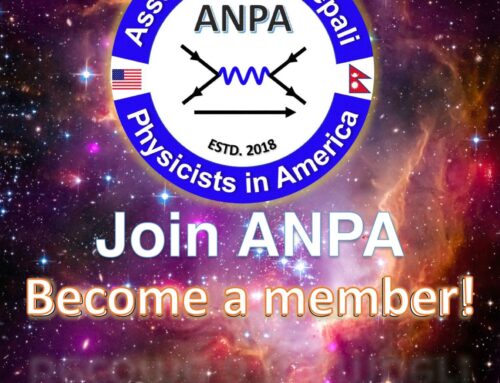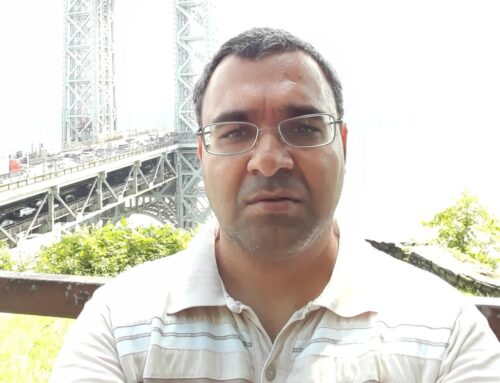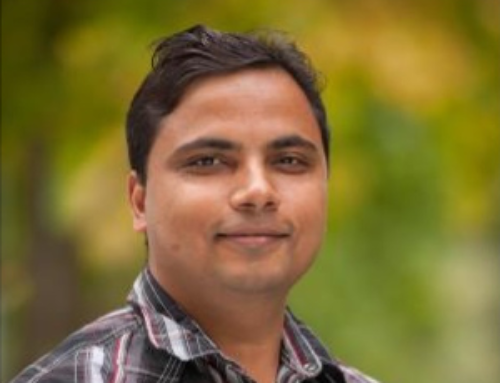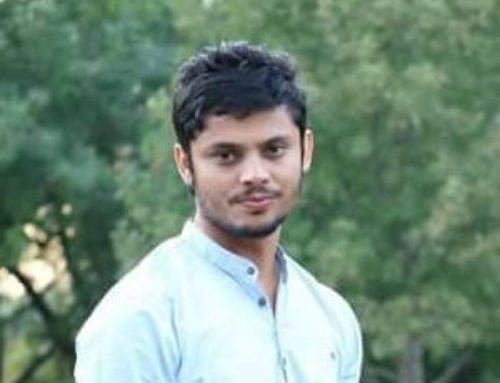Dr. Shambhu Ghimire
Born in a remote village far from the modern world, my childhood praised nature to the fullest. With no electricity in the village, technological appliances such as electric lamps, televisions, cellphones, and computers were not a part of our lives. A Person’s routine centered quite literally around the daylight. Their days would begin as the sun illuminates the beautiful range of the Himalayas at the north side of Nepal. Subsequently, nightfalls would demand a close-out of all activities. One of the most joyful nights of my life thus far was the night electricity was introduced into our new home, after our first move to a new town. All I remember from that night is delving into books all night long–– it was such a new and exciting feeling. Light became such a convenience to us; it was present everywhere at all times on our demands, something that people born in developed countries would take for granted. Another most memorable night of my life is more recent, which was when I had participated in a science experiment that utilized the world’s most intense flashes of X-rays in a newly built X-ray free-electron laser facility at the skirts of Palo Alto, California, in 2009. Since then I have met with so many such moments. Here, I describe how even a villager’s dream can come true through science, how my research career is advancing, and how our research in the area of laser science and technology is taking another leap in technology, which possibly have an impact in our lives similar to electricity.
There was a question that always crossed my mind around the time when I was in fourth grade: “Why does the sun always rise from the east, and why does it do so at about the same time every day?” I had no clue at the time, but, looking back now, this was a turning point and the beginning of my deep interest in nature and science. This is when I began to question how things worked in the way that they did in our everyday lives. You can either accept nature as it is, or you can think beyond the surface and ask yourself what the basic guiding principles of our universe are. There may not be any definitive answers even to these questions we hold, but it is a part of the life we live–– a life that is constantly changing. In high school, one unforgettable science experiment I conducted at home was electroplating teaspoons with copper. There were also many failed experiments in which I had attempted. One of which, I tried to ground an electrical wire physically to the ground of our front yard in lieu of trying to understand how electrical grounding works. This attempt, unfortunately, electrocuted me and I will never forget the frightening shock of how my hands were almost thrown out. Perhaps, this may not be one of the things that I’m proud of regarding my teenage offences.
After high-school, it was clear to me to study a science major. College education in Nepal at the time was very much influenced by the political instability of the country. Many times, classes were canceled abruptly and students found themselves in rallies organized by various political parties. My personal political views, however, will not go deeper than this in my writing. Promptly after finishing my formal college education in Tribhuvan University, I started exploring higher education opportunities abroad. Although it was done through post-mails, this exploration was only several months long, as I obtained admission in Kansas State University; I have to thank them for not discarding my application, as it did not enclose any application fee. Without credit cards or bank accounts I did not have a proper way to send payment. This was right after 9/11/2001, so at the time there was a lot of anxiety towards foreign students, particularly in big cities like Manhattan, New York. The quiet midwest, luckily, turned out to be an ideal place for me to focus on my studies.
My research area was ultrafast laser science, a technique which uses lasers to probe rapidly evolving dynamics that are too fast to observe by other means. Just how fast is too fast? Why do we care about such fast motions? In our surroundings, we can see that smaller things usually move faster. For example, you can compare a small rabbit with a large elephant in their physical motion. A rabbit can turn around in a split of a second while an elephant takes much longer to carry out the same motion. In addition, precisely observing very fast motions can be very difficult. For example, we could take a picture of a lake without any major issues but when it comes to taking photographs of waterfalls the shutter speed of the camera comes into play. Such images often get blurred because the water can be moving faster than the camera can capture. Therefore, tracing fast motions of small as well as very fast-moving objects is a challenging task.
Now, let’s be more specific about how small and how fast. Electrons are small subatomic particles constantly orbiting the nucleus. They are too small to be seen with the naked eye unless you are using an electron microscope. They orbit very similarly to how planets orbit around the sun. But, attributed to their size, the time scales are very different. Just like it takes 365 days for the earth to orbit the sun, for electrons to orbit around the nucleus of the atom it takes mere attoseconds, a billionth of a billionth of a second. To put things in perspective, comparing an attosecond to a second is like comparing seconds to the age of our universe. To take snapshots of such ultrafast motions, we needed to build the fastest possible camera we could. To take on that task, we employed super-fast flashes of laser pulses, something that took several years for us to construct. Our research team was able to craft such fast laser pulses, design an experimental setup, and essentially take the motion picture of electronic orbitals in atoms and molecules present in the gaseous medium. My PhD thesis adviser appeared on BBC news regarding the unique accomplishment of our group.
After finishing graduate school, I started to think about using the above mentioned laser techniques in applications that have more direct relevance to human life. Lasers have been already proven useful to advance technology in many ways. For example, it is used in fiber optics communications, precision measurements, cutting and welding of materials, etc. Lasers have several categories depending on their power, ranging from the red laser pointers that we use in our presentations, to a much more powerful laser beam that the military uses to bring unauthorized flying objects down to the ground in a few seconds. I started investigating general limitations in computers, cellular phones, and other electrical devices in terms of how fast they can operate and if lasers can push such limits. To understand the basic idea, we need to start from what sets the fundamental speed limits on the functionality of our contemporary electronics.
Speed limits in electronics, at the fundamental level, are essentially set by how fast the electrical current or voltage can be switched on, switched off, or amplified, such as in transistors, an electrical device first built in Bell Labs in the fifties and later revolutionized the electronics industry. Transistors are made up of semiconducting materials such as silicon and germanium. These materials have energetically allowed and energetically forbidden energy levels, much like how staircases consist of several steps which we can either walk up or walk down. In semiconductors, these are the electrons walking up or down the energy levels. Among many energy levels, there are two most important ones: the valence band and the conduction band, which are separated by a forbidden level called the bandgap. Normally, valence bands are fully occupied with electrons and conduction bands are empty. During operations, semiconductors are energetically pumped, usually by a battery, which means the electrons are promoted from the valence band to the conduction band. Electrons in the conduction band can freely flow from one place to the other, such as from one element of the circuit to the other. Unfortunately, a complete operation requires the electrons to go back down to the valence band, otherwise the material cannot be pumped again; this is what sets the fundamental speed limit. Currently, there is no active mechanism to bring the electron back down to the valence band. Instead, we just wait until they go back down on their own. This is the origin of the fundamental speed limit of our electronics. It is possible to slightly improve the speed, for example using a different material such as germanium in place of silicon, but substantial improvement is prohibited by the basic laws of physics.
I, and other scientists working in the field, believe that the use of strong ultrafast lasers could change the game completely. Lasers are electromagnetic waves consisting of electric and magnetic fields. The electric field is sinusoidal in its shape, which means that it has both positive and negative polarities, analogous to the positive and negative sides of a battery. But the main difference is that, first, the amplitude of the voltage can be more than a million-fold, and second, the switching from positive to negative voltage occurs very fast — essentially within the wavelength of the laser. It means that when we pump semiconducting materials with strong lasers the electrons can be pumped from the valence band to the conduction band very fast and similarly back down to the valence band at the same rate. Lasers essentially serve as a very strong battery whose polarity can be changed back and forth extremely fast. One of the main challenges is to be able to see or probe laser-driven ultrafast electron dynamics in semiconductors. Recently, my team at Stanford discovered a new approach to probe fast-moving electrons in materials, which is by measuring their radiation. Accelerated or decelerated electrons radiate lights of different colors or wavelengths depending on their instantaneous speeds. In the first experiments, we observed twenty-five different colors or wavelengths forming a rainbow-like spectrum from a zinc oxide semiconductor crystal subjected to intense laser pulse. These results indicate that the electrons are sweeping across both the conduction and valence bands with unprecedented speeds.
To obtain further insights, we are also using a special type of X-ray that are now available in modern x-ray free-electron laser facilities. X-ray machines that are being used at dental clinics or hospitals work similarly to light bulbs, where X-rays are emitted in all directions. The special X-ray machine I mentioned here is a laser, meaning that it produces a very directional and therefore extremely bright beam of X-rays. The first machine of this kind was constructed and commissioned at Stanford in 2009. The entire machine is quite long in size as it extends over 2 miles; it is powered by a gigantic particle accelerator. This machine has applications in a wide range of science and technology, including structural biology and medicine. As I write this article, several research groups are discussing X-ray laser’s potential application to probe the atomic-scale structure of COVID-19 — the current mega-public health issue in our society. The idea here is that if we can understand the virus mutation process in detail at the molecular level, we may be able to come up with ways to intercept such mutations.
In conclusion, lasers have enabled many technological advances that are vital to our daily lives. There are ongoing research efforts in my group as well as in many others aiming to once again revolutionize the tech industry. Next generation electronics could be based on the use of ultrafast lasers, which could increase fundamental speed limits in processors and electrical devices by about ten thousand-fold compared to the current-state-of-the-art, which is in the gigahertz range. It is, of course, hard to predict the future, but laser-based science and technology seem to be at the threshold of making another real difference in human lives, as did electricity. Personally, this has been a very exciting journey, particularly through the eyes of once a villager whose childhood was so far away from the modern world.
Dr. Shambhu Ghimire
Ultrafast Laser Science and Technology
Stanford PULSE Institute
SLAC National Accelerator Laboratory





Exciting story!